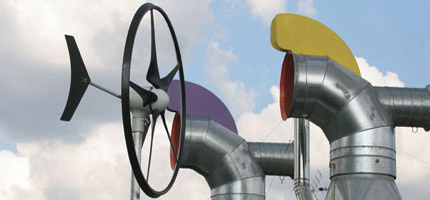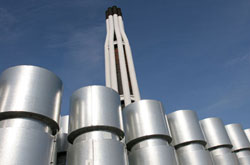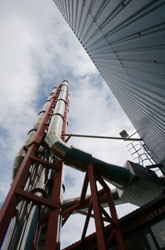
How does this happen? Well, generating electricity produces huge amounts of 'waste' heat, which is simply thrown away by our power stations - for example, as steam up the cooling towers.
On average, our large, centralised power stations throw away two thirds of the energy they generate.
If power stations are sited close to where heat is needed - say, near towns and villages or on industrial sites - then this heat can be captured and supplied to homes and businesses or used in industrial processes. The heat capture technology exists and is actually well established in countries like Denmark and the Netherlands. It's called Combined Heat and Power (or CHP), and CHP plants can be as much as 95 per cent efficient. Compare that to the old fashioned power plants we presently use, which are, on average, 38 per cent efficient.
 In the UK, CHP has enormous potential. On industrial sites where huge quantities of heat are needed, CHP plants can be similarly big. For example, the Immingham CHP plant, supplying two refineries in Humberside with heat, steam and power, iwas expanded in late 2009 to reach the same electricity generating capacity as the UK's flagship nuclear power station, Sizewell B.
In the UK, CHP has enormous potential. On industrial sites where huge quantities of heat are needed, CHP plants can be similarly big. For example, the Immingham CHP plant, supplying two refineries in Humberside with heat, steam and power, iwas expanded in late 2009 to reach the same electricity generating capacity as the UK's flagship nuclear power station, Sizewell B.
Vast untapped potential remains. On a relatively small number of industrial sites in the UK, there's enough CHP potential to provide the same electricity generating capacity as the whole of the proposed new generation of nuclear reactors combined. Such plants would take only a few years to build, would provide heat as well as electricity and, based on the reported investment at Immingham, would cost a fraction of the price.
Urban power
In addition to industrial sites, CHP works well in communities (especially cities) where CHP plants can be much smaller, and are extremely quiet and unobtrusive. In Southampton and Woking, for example, CHP plants are hidden in town centre car parks and most residents don't even know they're there. Piping heat from a smaller, ultra-efficient CHP unit within a town cuts consumers heating bills and provides a local source of heating and electricity in the most efficient way possible.
In Southampton, thousands of homes and many large businesses save both money and emissions by being part of the heat network and supplied by local CHP plants. Other cities like London and Birmingham have similar developments and plans, and on an even larger scale.
 If we combine the potential for CHP on industrial sites and in communities then, according to government figures, we could generate more than double the expected output of electricity from the proposed nuclear programme - in the same time frame, for less money and without the legacy of nuclear waste.
If we combine the potential for CHP on industrial sites and in communities then, according to government figures, we could generate more than double the expected output of electricity from the proposed nuclear programme - in the same time frame, for less money and without the legacy of nuclear waste.
CHP alone is not the complete solution - it still often uses fossil fuels. But, because it's the most efficient way possible to use these fuels, it cuts emissions and reduces fuel dependency immediately.
Moreover, CHP can use diverse fuels in the same boilers. This means that, as greener fuels like biomass (straw bales, for example, or waste wood pellets or certain specially grown crops) become available, they can be used in the CHP plants instead - with no need to refit the equipment, but with an immediate reduction in CO2 emissions and with the knowledge that these precious green fuels are also being used in the most efficient way possible.
Yet despite all this, the UK hasn't made much use of CHP. Whereas countries like the Netherlands and Denmark get half, or more, of their energy from ultra efficient CHP, in the UK today it's still a tiny fraction.
Find out more in our 2006 film on local, decentralised energy: What are we waiting for?


